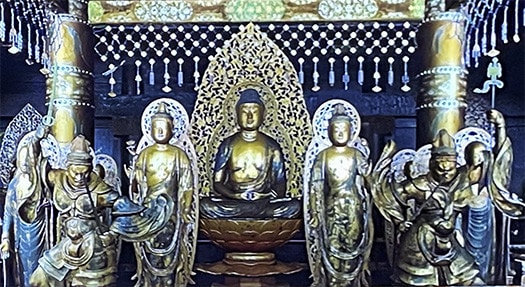



きのうの「仏像」ブログからの流れで、先日まで東京国立博物館で展示されていた中尊寺について。
日本社会の一般常識では「北海道東北」というカタチで一体表現される北部ニッポン地域だけれど、北海道は明治以降の日本の国防意識が発露した地域という特色であるのに対して、東北はこの奥州藤原氏の盛衰という要素が象徴的な対中央関係だったのだと思う。
日本の歴史の中で平泉政権ほど独立的な「地方政権」というものも珍しい。戦国期の地域政権のさきがけというようにも理解できるし、鎌倉政権には「独自権力のありよう」を具体的に提示した存在。こうした半ば独立した政権が中央からも認められて存立し得たのは「仏国土」思想を実践するという平和思想が創設者・藤原清衡によって高々と謳われていたことが大きいのだろう。
中央貴族・藤原氏との「同姓」という要素も活用しながら、平泉に具体的な黄金楽土を現実化したことで日本社会に独立色を容認させたように思える。
中尊寺金色堂は東北を駆け巡って仕事していた当時、ちょうど東北の中で中心的な位置にあって、どこへ移動するにせよ、ふと、こころに生起させられる地理的な場所だった。「ちょっと寄るか」。
そんなことだったので、相当の頻度で訪れているように記憶している。たぶん2度や3度ではない。メイン参道の終末近く、印象的な能舞台も右奥にある場所に金色堂はある。そこに至る専用の参道から見上げながら、たどりつく建物自体が黄金で彩られている様子が神々しい。
中尊寺金色堂の展示会が東京国立博物館で行われると聞いて、「え、あの建物はまさか持ってこられないでしょう」とやや驚かされていた。どうやら、内陣の仏像群が展示されるのだということだった。で、東北に縁のある者として、全国のみなさん,東京のみなさんがどこまで関心を持っていただけるか、なかば以上、地元民意識でハラハラとしていた。
ところが、実際に行って見ると「入場制限」の大行列(!)。たしか開場からほどない時間に向かったのだけれど、すでに「2時間ほどの行列」ということで、驚くやらうれしいやらという心理でした。わたし自身は数回これらの御尊像たちとは対面している記憶があるので、今回は諦めて、東京のみなさんに機会を譲らせていただいた(笑)。って、上から目線ではなく思って、それできのうご紹介した「東洋館・仏像」の方に向かったという経緯であります。
でもまぁ、ちょうど平成館から本館に移動する位置で「NHK/8K展覧会」が行われていて、そっちは立ち見でしたが、ごらんのように撮影もできた次第。
ほとんど仏像にはふれていないブログだけれど(笑)、上の2体の持国天像が戦乱の結果による平泉の成立を物語っているようにわたしには思えた次第。
English version⬇
The "Buddhist Land" philosophy of the Oshu Fujiwara clan in medieval Japan
I went to the Tokyo Museum to see the Chuson-ji Konjikido exhibition, but there was a huge line. I was disappointed and happy, but I felt like a "mixed bag. I told them that I would see the oriental Buddhist statues, so they should all see it. I was so excited.
Continuing on from yesterday's "Buddhist Statues" blog, I would like to talk about Chuson-ji Temple, which was on display at the Tokyo National Museum until the other day.
The northern part of Japan is often referred to as "Hokkaido-Tohoku" in the common sense of Japanese society, but while Hokkaido is characterized as the region where Japan's sense of national defense emerged after the Meiji period, I think that the rise and fall of the Oshu Fujiwara clan was symbolic of the Tohoku region's relationship with the center of the country.
In the history of Japan, it is rare to find a "local government" as independent as the Hiraizumi government. The Hiraizumi administration can be understood as the pioneer of the regional governments of the Warring States period, and it was a concrete example of the "independent power" of the Kamakura administration. The fact that such a semi-independent regime was recognized by the central government and was able to exist is probably due in large part to its founder, Fujiwara no Kiyohira, who highly advocated the peaceful ideology of practicing the "Buddha Land" philosophy.
It seems that the Fujiwaras, while utilizing the "same family name" as the central aristocratic Fujiwara clan, also made Japanese society more accepting of their independent color by creating a concrete golden paradise in Hiraizumi.
Chuson-ji Konjikido was at the center of the Tohoku region at the time when I was working all over the region, and it was a geographical place that would suddenly arise in my mind wherever I was going. I thought, "Let's stop by for a while.
So I remember that I visited there quite often. Maybe not two or three times. Konjikido is located near the end of the main approach to the temple, with the impressive Noh stage to the far right. Looking up from the dedicated approach to the temple, the building itself, which you reach while looking up from the approach to the temple, is decorated with gold, which is a divine sight.
When I heard that an exhibition of Chuson-ji Konjikido was to be held at the Tokyo National Museum, I was somewhat surprised, saying, "Oh, they couldn't possibly bring that building. Apparently, a group of Buddhist statues in the inner sanctuary will be exhibited. As someone who has ties to the Tohoku region, I was more than a little concerned about the level of interest that people from all over Japan and Tokyo would have in the museum.
However, when I actually went to the exhibition, I found a huge line of "limited admission" (!). I was surprised to see the line of people waiting to enter the exhibition. I was surprised and pleased to see that the line had already been long for two hours, even though I arrived not long after the doors opened. I remember that I myself have seen these statues several times, so this time I gave up and let the Tokyo visitors have their chance (laugh). So I gave up this time and let the people of Tokyo have the opportunity to see the statues (laugh).
But just as I was moving from the Heiseikan to the Honkan, the "NHK/8K Exhibition" was being held, and although I was standing in the audience, I was able to take pictures as you can see.
Although this blog is mostly about Buddhist statues (laugh), the two statues of Mochikokuten above seem to me to tell the story of the establishment of Hiraizumi as a result of the war.



















